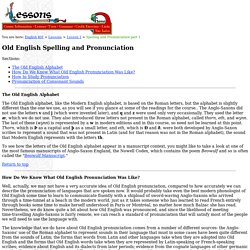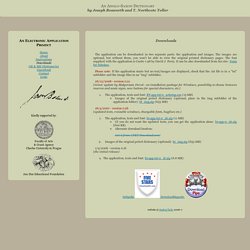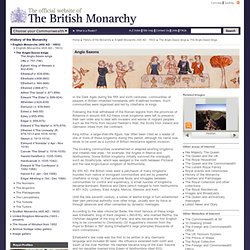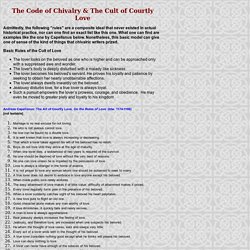

Old English Spelling and Pronunciation 1. You are here: English 401 > Lessons > Lesson 1 > Spelling and Pronunciation part 1 Sections: The Old English Alphabet The Old English alphabet, like the Modern English alphabet, is based on the Roman letters, but the alphabet is slightly different than the one we use, as you will see if you glance at some of the readings for the course..

The Anglo-Saxons did not use the letters v and j (which were invented later), and q and z were used only very occasionally. They used the letter æ, which we do not use. To see how the letters of the Old English alphabet appear in a manuscript context, you might like to take a look at one of the most famous manuscripts of Anglo-Saxon England, the Nowell Codex, which contains the poem Beowulf and so is often called the "Beowulf Manuscript.
" Return to top How Do We Know What Old English Pronunciation Was Like? How to Study Pronunciation Pronunciation of Consonant Sounds 1) (This is the easy part. B, d, k, l, m, n, p, r, t, x Sound Samples Return to Lesson 1. An Anglo-Saxon Dictionary of J.Bosworth & T.N.Toller. Downloads The application can be downloaded in two separate parts: the application and images.

The images are optional, but without them, you won't be able to view the original printed dictionary pages. The font supplied with the application is Cardo v.98 by David J. Perry. It can be also downloaded from his site: Fonts for Scholars . Please note: If the application starts but no text/images are displayed, check that the .txt file is in a "txt" subfolder and the image files in an "img" subfolder. 26/12/2008 - version 0.2c (minor update by Małgorzata Deroń - an installation package for Windows, possibility to choose between macron and acute signs, new buttons for special characters, etc.) The application, texts and font: BT-app-txt-0_2cSetup.exe (15 MB) Images of the original prited dictionary (optional, place in the img subfolder of the application folder): bt_img.zip (653 MB) 18/4/2007 - version 0.2b (updated texts, resizable windows, changable fonts, bugfixes etc.) File:Anglo-Saxon Chronicle - C - 871.jpg. The Anglo-Saxon kings.
In the Dark Ages during the fifth and sixth centuries, communities of peoples in Britain inhabited homelands with ill-defined borders.

Such communities were organised and led by chieftains or kings. Following the final withdrawal of the Roman legions from the provinces of Britannia in around 408 AD these small kingdoms were left to preserve their own order and to deal with invaders and waves of migrant peoples such as the Picts from beyond Hadrian's Wall, the Scots from Ireland and Germanic tribes from the continent. King Arthur, a larger-than-life figure, has often been cited as a leader of one or more of these kingdoms during this period, although his name now tends to be used as a symbol of British resistance against invasion.
The invading communities overwhelmed or adapted existing kingdoms and created new ones - for example, the Angles in Mercia and Northumbria. Ethelberht's law code was the first to be written in any Germanic language and included 90 laws. Featured English Monarch. Primary History - Anglo-Saxons - Who were they? Chivalry. The Code of Chivalry & The Cult of Courtly Love Admittedly, the following "rules" are a composite ideal that never existed in actual historical practice, nor can one find an exact list like this one.

What one can find are examples like the one by Capellanus below. Nonetheless, this basic model can give one of sense of the kind of things that chivalric writers prized. Basic Rules of the Cult of Love The lover looks on the beloved as one who is higher and can be approached only with a suppressed awe and wonder. Characteristics of the Code of Chivalry The same is true for the code of chivalry. Raymond Lull (1235-1315), Book on the Order of Chivalry (ca. 1270). A proper chivalric knight must be: able-bodied; of good lineage; have sufficient wealth to support his rank; wise (to judge his inferiors and supervise their labors; to advise his lord); generous within the limits of his means; loyal; courageous; honorable. His ethical duties are. Courtly Love - World History in Context. One of the most commonly held, and perhaps most misunderstood, modern notions about the Middle Ages is the type of romantic or erotic love believed to have been practiced in the period, popularly referred to as "courtly love.

" Courtly love is a cluster of related ideas and sensibilities characterizing an extreme expression of romantic passion that was demonstrated frequently by characters in medieval literature, especially in courtly romances and the love lyrics of the French troubadours and the German minnesingers. The term "courtly love" was never used in medieval texts, although medieval authors and poets did use the term fin'amors (refined love) to describe the extremes of emotion experienced, often suffered, by male protagonists in romances and by the lover singing love songs to his beloved in the lyric tradition.
But what exactly was the late medieval European phenomenon known popularly as "courtly love"? The knights and ladies at the aristocratic courts. A. E. W. J.